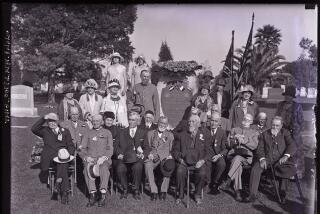South’s Upheavals Not Over With Bomb Verdict
BIRMINGHAM, Ala. — The bailiff snapped a pair of handcuffs tight around Bobby Frank Cherry’s wrists. And folks in this city of hills and honeysuckle unfurled the worn-out words of cliche: A chapter closed. The Old South put to rest. A chance for the New South to rise above an ugly, hateful past.
It was all true, as far as it went. But things are not that simple.
Cherry’s conviction this week in the 1963 bombing of a black Baptist church here that killed four young girls was hailed as a symbol of the South transformed. But the trial of the former Ku Klux Klansman did not speak to new tensions raking this proud, wary region.
The face of the population is changing in ways that some Southerners find threatening. The manufacturing and textile industries that have propped up the economy for decades are collapsing. A defiant Southern pride is surging. And new hatreds are welling.
The temptation is to see Cherry’s conviction “as some kind of proof that the past is over and done with,” civil rights activist Mark Potok said. But that neat symbolism ignores the fact that the South continues to change--in ways he sometimes finds scary. “There is a real resurgence of Southern white nationalism,” said Potok, who tracks hate groups for the Southern Poverty Law Center. “In a word: racism.”
This is not the racism that burst open into the raw brutality of Birmingham, circa 1960. Not the racism evoked by the Cherry trial, with its casual talk of white hoods and brass knuckles, of supremacists who gleefully bashed black marchers as police stood by.
That Birmingham, that South, is long gone. So long gone, in fact, that to many here the Cherry trial seemed less a symbol than a chore--a bit of historical housekeeping.
“A murderer got convicted of murder. That’s how the system is meant to work. Let’s not make too much of it,” said Bill Littlefield, 40, a Birmingham carpenter.
“For the younger generation of white Southerners, the wounds [that the Cherry trial laid bare] are not theirs,” said Joshua Rothman, an assistant professor of history at the University of Alabama. “It doesn’t feel part of their lives, and they don’t understand why they should have to deal with it.”
If his students expressed any passion about the trial, Rothman said, it was usually shame. “There’s the feeling that it reinforces the stereotypes of the redneck Southerner. [They ask], ‘Do we need more of that?’ And for them, the obvious answer is no.”
The stereotypes that made his students cringe are out of date.
In the early 1960s, Birmingham was fanatically segregated. Most Southern cities were. Now, four decades later, the 10 most segregated U.S. cities are all in the North, with Detroit, Milwaukee, New York, Chicago and Newark, N.J., heading the list.
In fact, the Northern city of York, Pa., is facing a trial just as freighted with historical bigotry as the Cherry case: The former mayor, who is white, has been charged in the murder of a black woman after race riots in 1969.
In the South, meanwhile, blacks--who couldn’t even vote 40 years ago--now hold the political power in many cities, Birmingham among them. And there are more scenes of easy interracial interaction today than even 10 years ago, on campuses, at parks, in offices.
The transformation seems obvious to African Americans like Alfred Mosley, 57. Standing outside a “Freedom Walk” dedicated to the “foot soldiers of the civil rights movement,” Mosley said he has seen good progress since he moved to Birmingham as a boy. “I can tell you,” he said, “that my daughter, Tomica, is about to graduate from UCLA. She’s had opportunities I never dreamed of.”
Or, as one civil rights activist, Rev. Fred Shuttlesworth, put it: “Birmingham today is not the same Birmingham.”
But for all the determined strides forward, echoes of the past reverberate--and seem to be getting louder, Potok said. He argues that the hatred embodied by the Cherry trial is spilling into the 21st century through the increasingly flinty rhetoric of the neo-Confederate movement--which has been driven in part by huge demographic shifts rocking the South.
Over the last decade, the region has been a magnet for migrants from all over the United States--drawing back hundreds of thousands of blacks who left during the Jim Crow era, plus almost as many whites seeking work or a quiet, warm place to retire.
At the same time--and for the first time in the region’s history--foreigners have started moving to the South in droves, drawn by low-skill agricultural work or high-tech computer jobs that are replacing the old textile mills.
“The ‘Old South’ population of native-born whites and native-born blacks has changed. There are a lot more colors in the palette now, a lot more faces in the crowd,” said Harry Watson, director of the Center for the Study of the American South at the University of North Carolina.
That transition has raised tensions among some old-guard Southerners, who fear that their culture is being diluted by transplants who don’t speak with a drawling twang, don’t reflexively say “sir” and “ma’am,” don’t swear by the noble righteousness of Gen. Robert E. Lee.
“If people are going to come here, they need to appreciate and become part of the South,” said Kirk D. Lyons, chief counsel of the Southern Legal Resource Center, a nonprofit preservationist group. “People moving down here shouldn’t try to bring the Bronx or Detroit with them.”
Under siege by Yankees and foreigners, Lyons and other traditionalists are fighting back--often by resurrecting the symbols of the Confederacy.
Neo-Confederate groups such as the League of the South have gained traction, attracting an estimated 9,000 members through high-profile fights to preserve Confederate flags and statutes of Confederate heroes.
The like-minded Heritage Preservation Assn. of Atlanta has organized marches and letter-writing campaigns. “For some reason, there are these crusaders who just love to bash us by nit-picking every bad thing that ever happened [in the South]. We resent that,” said Charles Lunsford, the group’s president.
Meanwhile, the Southern Legal Resource Center is taking scores of “heritage violations” to court--mostly cases in which students are disciplined for pinning the Confederate flag to their backpacks or for wearing a Lee T-shirt. (“They say wearing the Confederate flag at school is disruptive. Well, by God, so was integration,” Lyons said.)
Lyons and Lunsford dismiss the Cherry conviction as uninteresting and unimportant. “If he committed the crime, let him rot in jail,” Lunsford said. “The trial doesn’t mean a thing to me.”
It does, however, mean something--a great deal--to Horace Huntley, director of an oral history project at the Civil Rights Institute in Birmingham. He sees the Cherry trial not as a symbol of the end of an era, but as a spur to the beginning of a new one.
He hopes no one will be satisfied with the verdict. He hopes no one will be complacent.
Huntley wants Birmingham--the South, the nation--to start examining not just the bloody bigotry of the 1960s, but the economic inequities that drag too many African Americans down even today. He wants an honest reckoning of the insidious, subtle racism that he says has replaced the white hoods and brass knuckles of Bobby Frank Cherry and his buddies.
Huntley worries a bit that the snap of the handcuffs on Cherry’s wrists suggests a curtain drawn on an era, a pat conclusion to the horrors of the past.
“Some would say we have made it,” he said. “But we have to talk about how we make it to the next level. Or else we will leave our children with a mess.”
Times researcher Lianne Hart contributed to this report.
More to Read
Sign up for Essential California
The most important California stories and recommendations in your inbox every morning.
You may occasionally receive promotional content from the Los Angeles Times.










